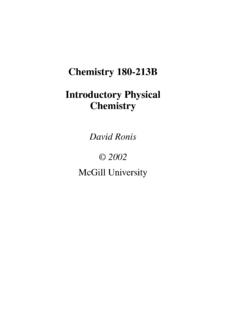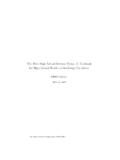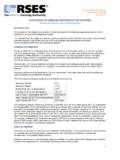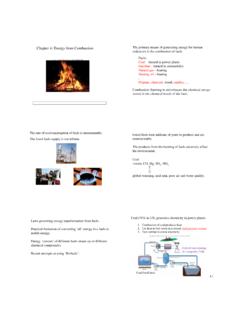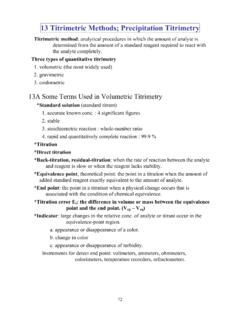Transcription of Chemistry 223: Introductory Physical Chemistry I
1 RA+ RB|v|t Chemistry 223: Introductory PhysicalChemistry IDavid RonisMcGill UniversityChemistry 223 Introductory PhysicalChemistry IDavid Ronis 2015 McGill UniversityAll rights reserved. Inaccordance with Canadian Copyright Law,reproduction of this material, in whole or in part, without the priorwritten consent the author is strictly truths are easy to understand once theyare discovered; the point is to in this grand book-I mean the universe-which stands continually open to our gaze, butit cannot be understood unless one first learns to comprehend the language and interpret the characters inwhich it is written. It is written in the language of mathematics, and its characters are triangles, circles, andother geometrical figures, without which it is humanly impossible to understand a single word of Galilei (1564 - 1642)Atheory is the more impressive the greater the simplicity of its premises is, the more different kinds ofthings it relates, and the more extended is its area of the deep impression whichclassical thermodynamics made upon me.
2 It is the only Physical theory of universal content concerningwhich I am convinced that within the framework of the applicability of its basic concepts, it will Einstein (1879 - 1955)The Founders of Thermodynamics and the Kinetic Theory of GasesJoule CarnotClausiusMaxwell Kelvin GibbsBoltzmannFall Term, 2015 General Information-4- Chemistry2231. GeneralInformationCHEMISTRY223: Introductory Physical Chemistry 1: Gas laws, kinetic theory of collisions. Thermodynamics: Zeroth lawofthermodynamics.
3 First lawofthermodynamics, heat capacity,enthalpy, thermochemistry,bond energies. Second lawofthermodynamics; the entropyand free energy functions. Third lawofthermodynamics,absolute entropies, free energies, Maxwell relations and chemical and thermodynamic equilibrium :CHEM 110, CHEM 120 or equivalent, PHYS 142, or permission of :MATH222 or :Not open to students who have taken or are taking CHEM 203 or CHEM ContactInformationProfessor: David RonisOffice: OttoMaass 426E-mail: my e-mail client direct your email;Please put CHEM 223 somewhere in thesubject.)Tutor/Grader: SamuelPalatoE-mail: OttoMaass 25 Lectures: Tuesday and Thursday 11:35 - 12:25 Makeups, Tutorials,or ReviewSessions:Friday 11:35 - 12:25 Location: Otto Maass 217 Course Web Site: : username and password areneeded for full , Fall TermChemistry 223-5- GeneralInformationIwill be awayonthe following dates and will makeupthe missed class in the Friday slot ofthe same week:Canceled ClassesMakeup(Fall, 2015)(OM 217, 11:35-12.
4 25)Tuesday,September 15 Friday,September 18 Tuesday,September 29 Friday,October 2 Tuesday,October 6 Friday,October TextsThomas Engel and Philip Reid,Thermodynamics, Statistical Thermodynamics, and Kinetics, 3rdedition(Pearson Education, Inc., 2013). Barrante,Applied Mathematics for Physical Chemistry ,3rd edition(Pearson Education, Inc.,2004). SupplementaryTexts1. Castellan, Physical Chemistry3rd edition (Benjamin Cummings , 1983) (Outof print but excellent. Thiswould be the text for the course if I could get copies).Note thatCastellan doesn tuse SI units and uses a older sign convention for an key-- thermodynamicquantity,namely Silbey, Alberty and Bawendi, Physical Chemistry ,4th edition(John Wiley&Sons, Inc.
5 , 2005). This was used as the text in the sOKbut Engel and Reid or Castellanare ,Thermodynamics(Physics orientation, excellent, but somewhat advanced with fewerchemical examples). GradesThere will be approximately one problem set every 2-3 lectures, one midterm and a finalexam. Themidterm will be givenbetween 6 and 9 onTuesday,October 27, 2015in Otto Maass 112 and 217 (a seating plan will be posted).Completion and submission of the homework is eatutor/grader for thecourse, Samuel Palato, and the problems will be graded. Solutions to the problem sets will beposted on the course web addition, there will be a tutorial roughly every second Fridaywhere the tutor will go overproblems or reviewother strongly encouraged to do the homework by yourself.
6 The problems will covermanydetails not done in class and will prepare you for the exams will involveextensive problem solving and may contain problems from the homework!The course grad-ing scheme is:2015, Fall TermGeneral Information-6- Chemistry223 Grade DistributionProblems 10%Midterm 40%Final 50% Random,McGill Specific, NotesMcGill University values academic , all students must understand themeaning and consequences of cheating, plagiarism and other academic offenses under theCode of Student Conduct and Disciplinary Procedures (see for moreinformation).(approvedbySenate on 29 January 2003)In accord with McGill University sCharter of Students Rights, students in this course have theright to submit in English or in French anywritten work that is to be graded.
7 (approvedbySenateon 21 January 2009)In the event of extraordinary circumstances beyond the University scontrol, the content and/orevaluation scheme in this course is subject to , Fall TermChemistry 223-7- Tentative Course OutlineText ChapterSilbey Reid : Kinetics&Thermodynamics, an overview properties of gases11,7 properties of liquids and solids11 basis: Kinetic theory of gases17 12,16 reactions & Effusion17 phase collision rates17 I:Collision theory of elementary gas phasereactions: Collision rates and activation free path & I: Review of n th order reaction to mechanims & steady state Temperature: thezeroth law of thermodynamics11 6 Lecture12.
8 Mechanics,Work, and Heat22 7 Lecture13. Reversible and irrev ersible changes22 7 Lecture14. TheFirst Law of Thermodynamics: Energy 22, 37 Lecture15. Enthalpy,Hess sLaw 23, 47 Lecture16. HeatCapacities, Kirchoff sLaw 247 Lecture17. EstimatingEnthalpy Changes: Bond Enthalpies24 7 Lecture18. TheCarnot Engine/Refrigerator35 8 Lecture19. TheSecond Law of Thermodynamics: Entropy 358 Lecture20. Entropy Calculations35 8 Lecture21.
9 TheThird Law of Thermodynamics: Absolute Entropies 359 Lecture22. ConditionsforStable Equilibrium: Free Energies 4610 Lecture23. EquilibriumConditions (continued)46 10 Lecture24. MaxwellRelations and applications46 Chemicalequilibrium 5611 Lecture26. Chemicalequilibrium calculations56 11 Divertissements-8- : Ryogo Kubo,Thermodynamics(North Holland, 1976) : Founders of the first law of thermodynamicsIf a tomb of the Unknown Scientists had been built in the 1850 s, the most appropriateinscription would have been "In memory of the grief and sacrifice of those who fought to realizeaperpetuum mobile".
10 But the lawofconservation of energy,orthe first lawofthermodynamics,is associated primarily with three great names, Mayer,Helmholtz and Robert Mayer (1814-1878) was really a genius who was born in this world only withthe errand to makethis great declaration. Hermann Ludwig Ferdinand von Helmholtz(1821-1894) gav ethis lawthe name "Erhaltung der Kraft" or "the conservation of energy". LikeMayer,hestarted his career as a medical doctor but livedaglorious life as the greatest physiolo-gist and physicist of the Prescott Joule (1818-1889) worked overforty years to estab-lish the experimental verification of the equivalence of work and the three, Mayer was the first who arrivedatthis lawand the last whose work wasrecognized.
